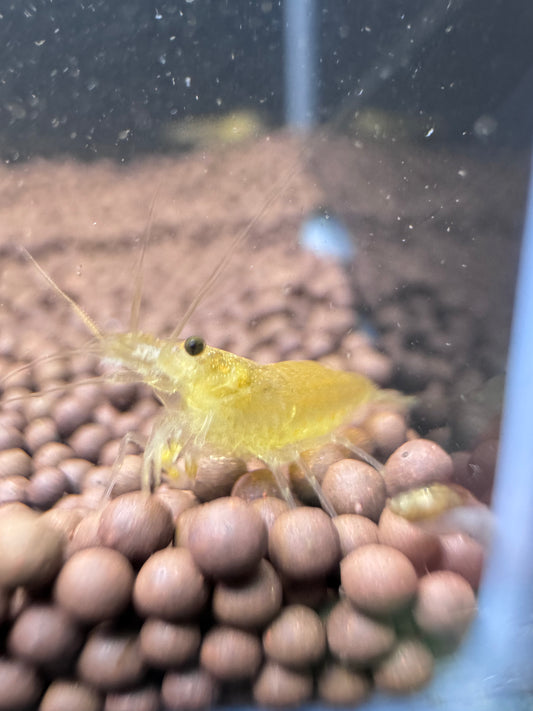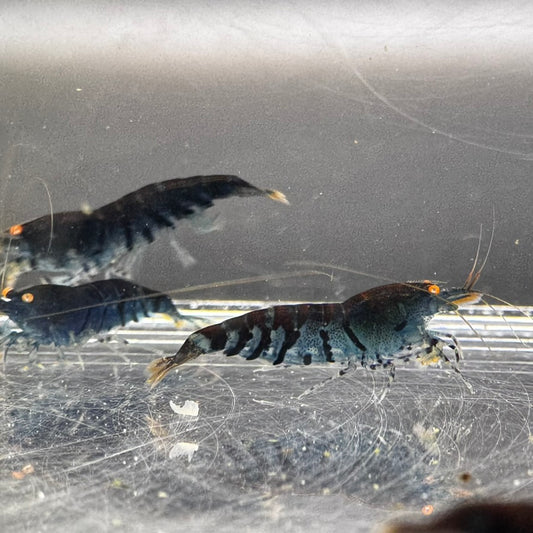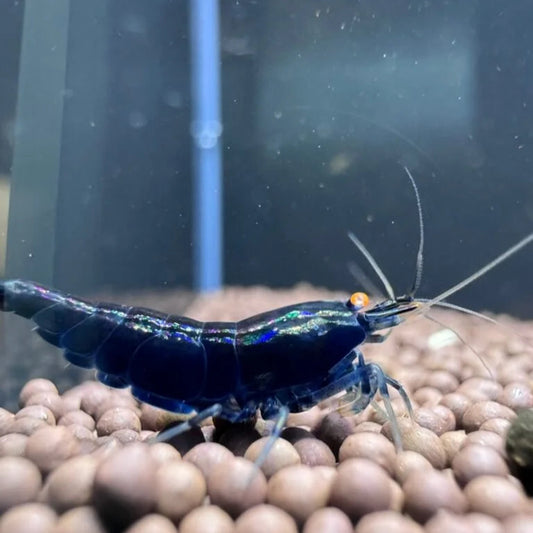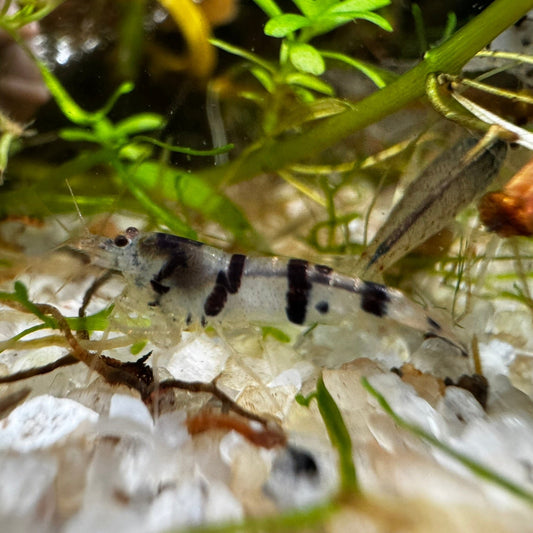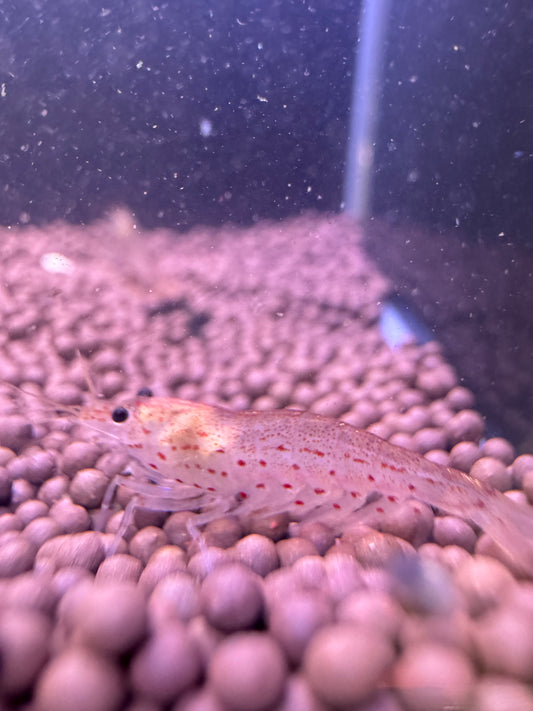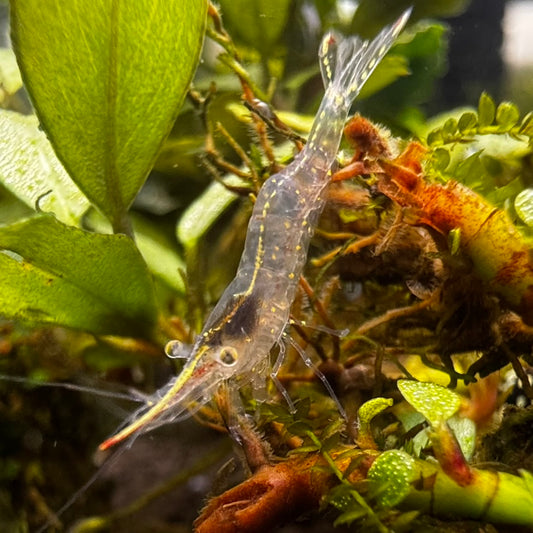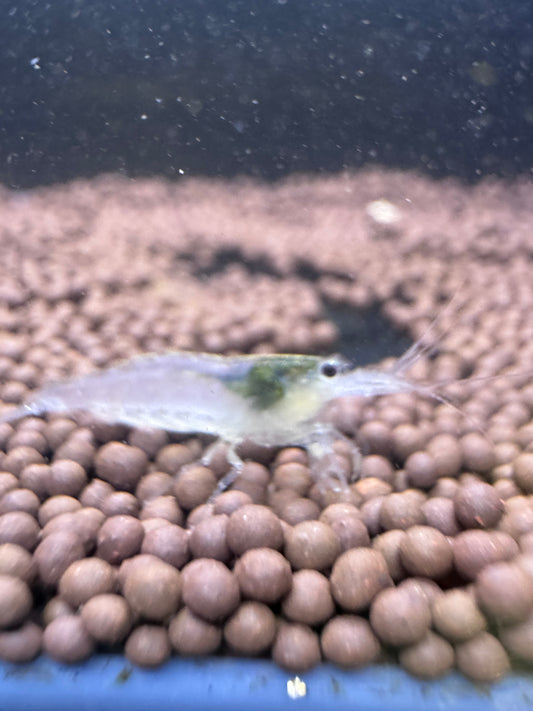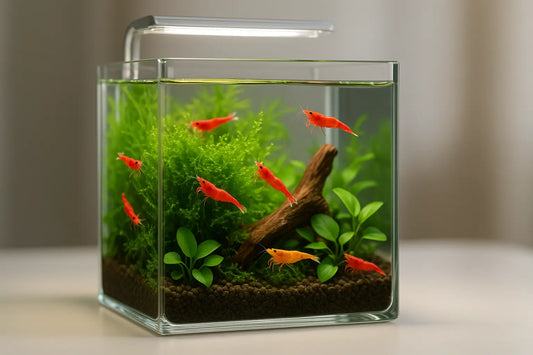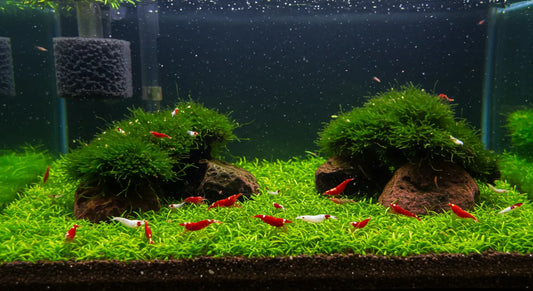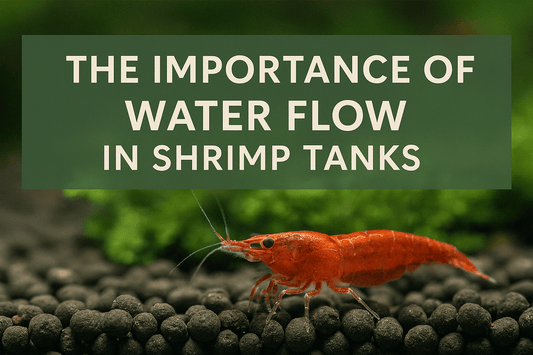Caridina in Neocaridina Parameters
Frequently Asked Questions About Caridina Shrimp in Neocaridina Parameters
What does "Caridina in Neo Parameters" actually mean?
"Caridina in Neo Parameters" refers to specific Caridina shrimp varieties that have been selectively bred to do well in water conditions typically suitable for Neocaridina shrimp. This is significant because:
- Most Caridina shrimp (like Crystal Red/Black, Taiwan Bee varieties) require specialized water conditions with very low mineral content, low pH, and often RO/DI water systems
- Neocaridina shrimp thrive in most tap water conditions (with proper conditioning) at a neutral to slightly alkaline pH (6.8-7.8)
- The varieties in this collection can flourish in standard freshwater parameters without the need for RO water or special remineralization
This adaptation makes these special Caridina varieties much more accessible to hobbyists who don't want to invest in specialized water treatment systems or maintain separate parameter-specific tanks.
Which Caridina varieties can live in Neocaridina parameters?
Several Caridina varieties have been selectively bred to do well in standard freshwater parameters. The key species in our collection include:
- Raccoon Tiger: Distinctive striped pattern similar to tiger shrimp but more adaptable
- Tangerine Tiger: Specially bred line of Tiger shrimp adapted to standard parameters
These varieties maintain their stunning Caridina colors and patterns while being much easier to keep than their specialized counterparts.
Are these shrimp as colorful as traditional parameter-specific Caridina?
Yes! The Caridina varieties in this collection maintain their stunning colors and patterns despite their adaptability to Neocaridina parameters. They offer:
- The same vibrant colorations as their parameter-specific counterparts
- Stable genetics for color inheritance
- The distinctive patterns and features that make Caridina so sought-after
The key difference is their tolerance for a wider range of water conditions, not a compromise in appearance.
Our careful breeding selection focuses on maintaining color quality while improving hardiness, giving you the best of both worlds.
Can these adaptable Caridina live with Neocaridina shrimp?
Yes! One of the major advantages of our "Caridina in Neo Parameters" collection is that these shrimp can coexist with Neocaridina varieties in the same tank. This allows you to create multi-species displays without needing multiple specialized setups.
Benefits of keeping them together:
- Create visually striking displays with different patterns and colors
- Maintain just one set of water parameters
- Observe interesting behavioral differences between species
Important considerations:
- Caridina and Neocaridina cannot interbreed as they are different species (no hybrid concerns)
- The Caridina varieties may still appreciate slightly lower temperatures (70-74°F is ideal)
- Both appreciate similar foods, plants, and hiding places
Popular combinations include Orange Eye Blue tiger with Yellow Neocaridina or Orange Neocaridina for striking color contrasts.
What tank setup is ideal for Caridina in Neo parameters?
The ideal tank setup for these adaptable Caridina varieties is similar to a standard Neocaridina setup, with a few optimizations:
- Tank size: 5+ gallons, with 10+ gallons being ideal for stable parameters
- Filtration: Gentle sponge filter or HOB/canister with sponge pre-filter
- Substrate: Inert substrates like sand, fine gravel, or neutral aquasoil that doesn't lower pH dramatically
- Plants: Live plants are highly recommended - moss, Bucephalandra, Anubias, and floating plants
- Hardscape: Driftwood, cholla wood, and leaf litter (Indian almond leaves, mulberry leaves)
- Hiding places: Plenty of caves, plant thickets, and shaded areas
- Light: Moderate lighting (these Caridina appreciate some shadowed areas)
While these Caridina can adapt to standard parameters, they'll show their best colors and highest activity in the middle of their acceptable range. Aim for:
- Temperature: 68-74°F (21-23°C)
- pH: 6.8-7.4
- GH: 6-8
- KH: 2-4
For optimal habitat, check out our live plants and botanicals collections.
Will these Caridina breed in Neocaridina parameters?
Yes! One of the most exciting aspects of these specialized Caridina varieties is their ability to successfully breed in standard freshwater parameters. Unlike many traditional Caridina that require specific conditions to reproduce, these adaptable varieties will breed readily in Neocaridina parameters.
Breeding characteristics:
- Females carry fewer eggs than Neocaridina (typically 10-25 vs 20-30)
- Gestation period is similar (3-4 weeks)
- Hatchlings emerge as fully-formed miniatures (no larval stage)
- Breeding occurs less frequently than Neocaridina (every 5-8 weeks vs 3-5 weeks)
- Shrimplets may need slightly more microfoods to thrive (Bacter AE and Shrimp Baby are ideal)
To encourage breeding:
- Maintain stable parameters - consistency is key
- Provide plenty of hiding places for shrimplets (moss is excellent)
- Keep a mature tank with established biofilm
- Ensure proper nutrition with quality foods
- Maintain optimal temperature range (70-74°F)
While these specialized Caridina will breed in standard parameters, they typically reproduce at a slower rate than Neocaridina, so patience is recommended.
Are these adaptable Caridina suitable for beginners?
These special Caridina varieties are ideal for intermediate beginners - hobbyists who have successfully kept Neocaridina shrimp for a few months and are looking to expand their collection with more exotic varieties.
Why they're more beginner-friendly than traditional Caridina:
- No need for expensive RO/DI water systems
- Tolerate parameter fluctuations better than traditional Caridina
- Can thrive in conditioned tap water (if within acceptable parameters)
- Less sensitive to TDS and GH changes
- Can be kept in the same tank as Neocaridina
Recommended preparation for success:
- Have 3+ months experience keeping Neocaridina successfully
- Understand basic water parameter testing
- Have a well-established, cycled tank (3+ months old)
- Be comfortable with proper acclimation techniques
- Understand the nitrogen cycle and maintenance routines
If you're completely new to shrimp keeping, we recommend starting with our Neocaridina collection for a few months before advancing to these adaptable Caridina varieties.
How do I acclimate these Caridina to my aquarium?
While these Caridina are more adaptable than their traditional counterparts, proper acclimation is still crucial for their success. We strongly recommend the drip acclimation method:
- Let the bag acclimate to room temperature in the bag
- Transfer shrimp and shipping water to a clean container (plastic bowl, container, etc.)
- Set up a drip line using airline tubing with a loose knot or control valve to regulate flow
- Drip tank water into the container at a rate of 1-2 drops per second
- Continue the drip process for 60-90 minutes, until the container volume has at least tripled
- Gently transfer shrimp to your tank using a net, discarding the acclimation water
Special considerations for these Caridina:
- Aim for a slightly longer acclimation period than with Neocaridina (90 minutes vs. 60 minutes)
- Keep lights off for the first 24 hours after introduction
- Avoid feeding for the first 24 hours to allow shrimp to settle
- Monitor closely for the first week, watching for successful molting
For a detailed visual guide to the acclimation process, check our complete drip acclimation tutorial.
What's the difference between these and standard Caridina varieties?
The primary difference between our "Caridina in Neo Parameters" varieties and standard Caridina shrimp is their adaptability to a wider range of water conditions. Here's a comparison:
| Feature | Standard Caridina Varieties | Our Adaptable Caridina Varieties |
|---|---|---|
| Water Requirements | Very specific (low pH, low GH/KH, RO water) | Flexible (standard tap water with conditioning) |
| Setup Complexity | High (RO systems, remineralization, pH buffering) | Moderate (similar to Neocaridina setup) |
| Initial Cost | Higher (specialized equipment needed) | Lower (standard equipment sufficient) |
| Breeding Difficulty | More challenging, specific parameters required | Moderate, will breed in standard parameters |
| Compatibility | Limited to other Caridina with similar requirements | Can be kept with Neocaridina and compatible fish |
| Color/Pattern Quality | Excellent | Excellent (no compromise in appearance) |
| Parameter Stability | Requires high stability | More tolerant of minor fluctuations |
Genetically, these are still pure Caridina species - they've simply been selectively bred over many generations to tolerate a wider range of conditions. This makes them perfect for shrimp enthusiasts who want to experience the beauty of Caridina without the complexity of specialized water systems.
What should I feed these adaptable Caridina shrimp?
These specialized Caridina varieties benefit from a varied diet similar to Neocaridina, but with slightly higher protein requirements:
- Staple foods:
- Bacter AE - Essential for promoting biofilm growth
- Shrimp Baby - Perfect for juveniles and supporting breeding
- ShrimpFit - Complete nutrition with vitamins and minerals
- Protein supplements:
- Protein XP - High-quality protein supplement
- Growth Envy - Promotes healthy growth and molting
- Mineral supplements:
- Mineral Junkie - Essential minerals for proper molting
- Shell Envy - Supports exoskeleton development
- Natural supplements:
- Indian Almond Leaves - Natural food source and health booster
- Cholla Wood - Creates biofilm surface and hiding places
- Mulberry Pollen - Nutrient-rich natural food
Feeding recommendations:
- Feed small amounts daily rather than large amounts occasionally
- Remove uneaten food after 2-3 hours
- Rotate between different food types for nutritional variety
- Use Bacter AE 2-3 times weekly for consistent biofilm development
- Increase protein slightly during active breeding periods
While these Caridina are more adaptable than traditional varieties, proper nutrition is still essential for vibrant colors and successful breeding.
What are the advantages of these adaptable Caridina over standard Neocaridina?
While Neocaridina shrimp are wonderful beginner-friendly invertebrates, our adaptable Caridina varieties offer several distinct advantages:
- Unique patterns and colors: Caridina species display striking patterns and color combinations not available in Neocaridina lines
- Eye variations: Features like the distinctive orange eyes on Black Devils and Tiger varieties create a striking appearance
- Slightly smaller size: Most adaptable Caridina grow to 0.8-1.2 inches, slightly smaller than Neocaridina (1-1.5 inches), allowing for higher population density
- Different behavior patterns: Many hobbyists observe more active foraging and less hiding with certain Caridina varieties
- No interbreeding concerns: Can be kept with Neocaridina without hybrid offspring concerns
- Conversation starters: These adaptable Caridina varieties are still relatively uncommon, making them impressive display specimens
- Selective breeding potential: Perfect for hobbyists interested in developing new color variations without needing specialized setups
- Different grazing habits: Some Caridina varieties target different types of algae and biofilm than Neocaridina
These adaptable Caridina offer the exotic appeal of specialized shrimp varieties without the complexity of maintaining strict water parameters, making them an excellent progression from Neocaridina for advancing hobbyists.
How do these compare to wild-type Caridina?
Our adaptable Caridina varieties share ancestry with wild Caridina species but have been selectively bred for both coloration and environmental adaptability. Here's how they compare to their wild counterparts:
- Appearance: Wild Caridina typically display muted, natural coloration with subtle patterns. Our varieties feature vibrant, eye-catching colors and distinct patterns developed through selective breeding.
- Adaptability: Wild Caridina often come from specific habitats with narrow parameter ranges. Our varieties have been bred over generations to tolerate a broader range of conditions.
- Size & Lifespan: Similar to wild specimens (0.8-1.2 inches, 1-2 year lifespan), though some cultivated varieties may have slightly shorter lifespans due to selective breeding.
- Behavior: Our adaptable varieties generally retain the natural behaviors of their wild ancestors, including feeding patterns, breeding cycles, and social interactions.
- Breeding: Wild Caridina often produce more offspring per clutch but with lower survival rates. Our cultivated varieties typically have slightly smaller clutches but better juvenile survival rates.
The adaptation to standard aquarium parameters has been achieved through careful selective breeding over many generations, not through any genetic modification. This results in shrimp that maintain their natural behaviors while being more suitable for home aquaria.
How stable are the colors in these adaptable Caridina?
The color stability in our adaptable Caridina varieties is excellent. Through careful selective breeding, we've developed specimens that maintain vibrant coloration even in standard freshwater parameters. However, as with all shrimp, several factors can influence color intensity:
- Diet: Proper nutrition with color-enhancing foods supports vibrant colors
- Light: Moderate lighting usually produces the best coloration (too bright or too dim can affect appearance)
- Background: Dark substrates often make colors appear more intense
- Stress factors: Sudden parameter changes, predators, or aggressive tankmates can cause temporary color fading
- Age: Juveniles typically develop full coloration after several molts
To maintain optimal coloration:
- Maintain stable water parameters
- Provide a stress-free environment with plenty of hiding places
- Use a dark substrate to make colors pop
- Provide 8-10 hours of consistent lighting daily
While these adaptable varieties show excellent color stability, it's normal to see some variation within a colony, which adds to the unique character of your shrimp display.
Why are some Caridina adaptable to Neo parameters while others aren't?
The ability of certain Caridina varieties to thrive in Neocaridina parameters is the result of both natural adaptability and selective breeding:
- Natural habitat variation: Some Caridina species naturally come from habitats with more variable water conditions, giving them a genetic predisposition to adaptability
- Selective breeding: These adaptable varieties have been selectively bred over many generations, with breeders specifically choosing specimens that show the best health and coloration in standard parameters
- Species differences: Some Caridina species (like those in the Tiger group) are naturally more adaptable than others (like Taiwan Bee varieties)
- Genetic factors: Certain genetic lines within species carry traits for better osmoregulation and physiological adaptability
Popular Caridina species like Crystal Red/Black Shrimp and most Taiwan Bee varieties (Blue Bolt, Panda, Wine Red, etc.) remain sensitive to parameters because:
- They originate from very soft, acidic water habitats
- Their selective breeding has focused primarily on color intensity rather than parameter adaptability
- Their physiological adaptations for ion regulation are optimized for low-mineral environments
Our collection specifically focuses on Caridina varieties with the genetic predisposition for adaptability, which we've further enhanced through generations of selective breeding in Neocaridina-type parameters.

